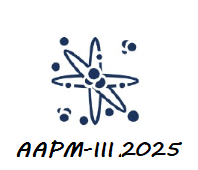All papers and reports must be in the scope of the conference:
- Practical Physics and Mathematical Applications in Energy Conversion and Optimization
- Applied Physical Sciences and Mathematical Modeling in Climate Change
- Engineering Physics and Quantitative Analysis in Geological Resource Management
- Biomaterials Science, Biomechanics and Biological Physics
- Environmental Physics: Integrating Physical Principles and Mathematical Models for Sustainable Energy and Ecosystem Management
- Applied Physical Principles and Mathematical Techniques in Renewable Energy Technologies
- Physics and Mathematical Approaches in Environmental Science
- Biophysics, Bio (Electro) Magnetism and Biophysical Chemistry
- Interdisciplinary Approaches to Sustainability through Applied Physics and Mathematics
- Nuclear Physics, Radioactivity, Radiochemistry and Radiation Safety
REQUIREMENTS FOR PAPERS
The requirements and templates for the papers can be found here
All papers must fit the scope of the conference
Templates and guidelines for proceedings papers
These are templates and guidelines for proceedings papers, they are there to to help you prepare your work.
Essential guidelines
Please follow these essential guidelines when preparing your paper
Templates
Authors must prepare their papers using Microsoft Word template:
One author should not submit more than two articles to the conference. This includes papers that they have co-authored.
Paper format
- There are no page numbers, headers or footers within the paper.
- Text is single spaced, not double spaced.
- All fonts are embedded.
- All pages are portrait (landscape pages should be rotated).
- The abstract text should be indented 25mm from the left margin and there should be 10mm space after the abstract before you begin the main text of your article, starting on the same page as the abstract.
- The paper includes the author name(s) and affiliation(s) (full address including country).
- All articles must contain an abstract.
- All figures and tables should be numbered in numerical order. Please ensure that figure/table numbers are not duplicated or missed.
- Figures are legible and placed within the text, not collected at the end of the document.
- If section headings are numbered, ensure that they are numbered numerically, and no numbers are duplicated or missing.
- Displayed equations should follow a naming convention in numerical order, i.e. (1), (2), (3) etc or by section, i.e. (1.1), (1.2) etc. Ensure every displayed equation has its own number and none are duplicated or missing.
- Reference lists are checked for accuracy. References can only be linked via CrossRef if they are correct and complete.
- If numbering references (Harvard system) ensure that references are numbered numerically, every reference has its own number and no numbers are duplicated or missing.
- Ensure that all references are cited in the text and that all citations have a corresponding reference.
- Finally, please ensure that the paper is thoroughly proofread to check the standard of English and ensure wording is clear and concise.
- Structure the paper, using the following subheadings to identify each section: Background, Purpose, Methods, Results, and Conclusion.
§ Purpose/objective
§ Methodology
§ Results/findings
§ Conclusions
Conversion to PDF
- The PDF file is editable and not password protected.
- The PDF is free of formatting errors (e.g. corrupt equations, missing or poor-resolution figures), since conversion from Word to PDF can introduce formatting errors.
- There are no blank pages.
- Submitted articles must be the authors’ own work, expressed in their own words. Plagiarism constitutes unethical scientific behaviour and is never acceptable. Plagiarism ranges from the unreferenced use of others’ ideas, to replication (without sufficient attribution or use of quotation marks) of sections of text from other sources, to submission of a complete paper under ‘new’ authorship. Papers with similarity rate more than 30 percent will be rejected.
REVIEW PROCESS
After double-blind reviewing, accepted and presented on the Conference papers will be sent to International Proceedings for publishing.
Each paper is checked for similarity in iThenticate by the Publisher.
Organizing Committee will send each paper to 1 or 2 independent reviewers, experts in the area of the paper.
1) Relevance to the conference directions
2) Scientific-technical originality, potential impact and interest for the audience
3) Scientific and technical content, novelty and importance
4) Quality of the presentation, clarity of the content
5) Comments for all authors will be given by the reviewers
The reviewers are going to indicate their familiarity with the paper's subject, evaluate the paper along the aforementioned criteria. Finally, the Organizing Committee will decide what papers will be accepted. But the final decision is taken by the Publisher.
Each paper is checked for similarity in iThenticate by the Publisher.
Organizing Committee will send each paper to 1 or 2 independent reviewers, experts in the area of the paper.
So, each paper will be evaluated by two independent experts according to the following Criteria:
1) Relevance to the conference directions
2) Scientific-technical originality, potential impact and interest for the audience
3) Scientific and technical content, novelty and importance
4) Quality of the presentation, clarity of the content
5) Comments for all authors will be given by the reviewers
The reviewers are going to indicate their familiarity with the paper's subject, evaluate the paper along the aforementioned criteria. Finally, the Organizing Committee will decide what papers will be accepted. But the final decision is taken by the Publisher.
